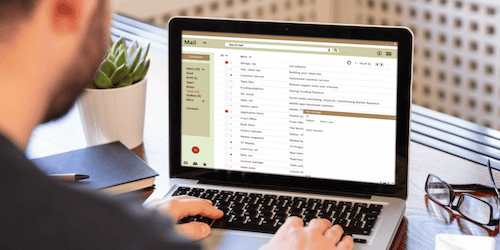
Association Email Marketing: A Complete Guide
In 2023, the average American spends over 8 hours with digital media every day. This same person, during that time, is checking their inbox 15 times.
For associations to stand out in the current market, they need to harness the power of digital channels, and especially email.
Association email marketing has proven to be an effective tool for associations to communicate their mission, drive membership growth, and foster meaningful relationships with their constituents.
In this article, we’re going to focus on the value of association email marketing before we deep dive into the before, during, and after of creating an email that grabs attention and gets results.
Why association email marketing?
Email isn’t the newest marketing channel, but that doesn’t mean it isn’t worth investing in. It’s usually worth trying new things, but knowing what works for your audience is half of marketing.
Most agree the first email was sent in 1971 from Ray Tomlinson to Ray Tomlinson, though there is a fierce debate in some circles. The technology has advanced steadily since then, but for most of us, email feels pretty much the same.
In our State of Nonprofit Marketing report where we surveyed associations and charity nonprofits, we heard back about their challenges, priorities, and plans for 2023, and we gathered some big insights.
Email marketing is pivotal for the sector. We found that 94% of our respondents placed email in their top five channels — second and third were organic social and digital ads with 67.3% and 67.1%.
We weren’t surprised email came in first, but we were a little surprised by how much it beat the competition!
You own your email list
One thing that sets email apart is the fact that you own your email list. There’s absolutely no one in between you and your audience.
This isn’t the case for many other marketing channels. On social media, you may have followers, but the platform ultimately owns the relationship. And with digital ads, you may own some of the data, but you’ll have to pay to place those ads on others’ sites.
Effective marketing leverages paid and owned channels, but building up your own data and your own contacts is always going to pay off in the long run.
Before you build the email
Making a list, checking it twice
Marketing always begins with a market. This may sound cliche, but before you start building that email, you need to identify who it’s going to.
If the people on your list are the right ones, and your message was built with them in mind, you’re going to be happy with the results. If they aren’t the right people, no amount of time or energy spent on messaging is going to make a difference.
Your list matters because this is the key to keeping unsubscribes, spam complaints, and costs down. It’s also one of the easiest fixes for boosting deliverability, open rates, and engagement.
Cleaning your email lists regularly — at least once every year, and more if your lists are quickly expanding — is step one.
Here’s a link to a how-to guide for cleaning your email lists, but at the heart of building and cleaning your lists is the idea of segmentation. Segmenting your audience into smaller groups so that you can address specific preferences and needs is the key to making sure you’re sending the email to the right person.
It’s often said that effective marketing is about getting the right message in front of the right person at the right time. And we totally agree with that idea, but all of those things ultimately start with the right person. Only when that person is identified can you then build a message that’s right for them and plan where to meet them with it.
The basics of audience segmentation
So how do you segment your association’s audience and get your message in front of the right person?
Start with what you already know. Your CRM and email service provider (ESP) likely have better ideas about your community than a list of best practices.
Your CRM or ESP should have a lot of key data points. Here are a few things to unpack:
- Relationship: Are they current members? Lapsed members? Regular attendees? How would they say they’re connected to your organization?
- Intent: Were they members in the past? Or do they only attend your annual event?
- Source: How did they find you? Did they meet you at an event and write down their contact info? Did they sign up online to get access to your content? Did they hear about you on LinkedIn or Facebook?
- Interest: This is a mix between source and intent. What drew them to your organization? Was it a specific event or a specific program? You may not know exactly why someone partners with your association, but asking and marking what drew people in will help tons in your communications.
- Location: Where do they live and work? Are they a short drive or a six-hour flight away from your next event?
In our Good Marketing Framework, we consider all these pieces of information to all fall under context and intent. Every relationship that we form with another person includes some amount of information, and we don’t get this information unless we’re listening closely.
Are you really someone’s friend if you don’t pay attention to what’s going on in their life?
By forming real, lasting connections with your audiences, you’re building the trust to together push your association email marketing and community forward.
Rinse and repeat
There are some recipes where it’s best to start from scratch, but often, using some prepped foods will save you enough time to justify the difference.
And this is especially true for email. Once you’ve built one good email, keeping that consistent brand feel in the email is actually a plus and not a minus.
Create a couple templates that you can use again and again to save yourself time. You’ll keep your branding consistent and you’ll save yourself the trouble. That’s a win-win in my books!
But because a template worked one time doesn’t mean it’s perfect. Consistently testing ideas will give you a better working knowledge of your community and keep your marketing from getting stuck.
Some audiences respond better to less branded emails while others like seeing your logo and colors. Keep doing what works for your community, but every once in a while, try something out of the ordinary and see how your people respond.
Looking for automated email templates to use?
We've got you covered! We know one of the hardest parts of any work is going from 0 to 1 so we built these templates to help you jump into the wonderful world of automated emails.
Setting the right goals
Now that you know the who of your email, it’s time to set the expectations of where you want to go with them. Your email is much more likely to be successful if you identify what would make it successful before building it.
Is the goal of the email to educate, entertain, or entice? Are you looking to sign up members or gain attendees? What’s the end goal?
Connecting your goal to a specific action you want your community to take helps connect the purpose with the people that you serve. Instead of working backwards from a revenue goal, spend time identifying who your organization has a relationship with, and then plan out the right next step for that specific person — or segment of people.
Not every marketing campaign should be attached to a direct revenue goal. Marketing has the unique perspective of building long-term relationships, and these long-term relationships are going to have a tremendous impact on revenue. But they often require time to grow. Rushing the process may help you get immediate results at the cost of bigger results.
Here are a few ideas for goals you may have during your upcoming email campaign:
- Increase newsletter subscribers.
- Expand your email list.
- Boost website traffic.
- Sign up new members.
- Pick up new attendees.
Everyone is at a different place in their relationship with your organization. The dating analogy may be overused, but it’s often helpful. Proposing on a second date most likely won’t go well. Asking the right questions at the right time is a lot of what effective marketing is about. And no one asked a good question without first truly listening.
Think of data as the way that your community talks to you. They likely tell you what type of communications they prefer through their reactions to them. Tracking every campaign and allowing responses to inform your campaigns is going to have a big impact on your results.
One last consideration before you start
Now you’ve decided who you’re sending your email to, and you know what you want it to do. Those are big questions, and your email is going to be a lot stronger with them answered.
But there’s one last question you should answer before you jump into the building phase.
In the past, an email was really just an email. But today, with email automation, you can set up your email to do a lot of the work for you.
What if someone landed on the registration page for your upcoming event but didn’t sign up? With an auto send email, you can now follow up with this person with a well-timed email in their inbox, reminding them of their already expressed interest in your event.
Listening to your audience is key to saying the right thing. You’re listening to your audience by noticing what pages on your website they’re traveling to, and then you’re engaging with them in dialogue by sending an email about the topic they’ve told you they want to hear more about.
While you build the email
If you’re looking specifically for a design-focused guide, here's a great resource. And there are books and books on copywriting and content marketing. We’ll get into some of the widely accepted best practices in these areas, but we think effective marketing starts with people and not best practices.
Because your audience is different from every other audience, there isn’t one strategy that’s going to work perfectly for you. You’re unique, and your community is too.
This means that instead of best practices, the best steps forward are to listen, test, and measure. Using your own audience and your own data as your guides will allow you to cut through the noise and connect to your community.
Listening can include a lot of things: interviews with your community members, surveys of current or prospective supporters, donors, or members, or general research within your market.
It’s key that an email starts and ends with the reader in mind. It shouldn’t be built primarily from an organizational goal — there’s a person on the other side of that send! If they feel like they’re just a number in your operation, they’ll likely look elsewhere. If they feel valued, they’ll likely be on your team for life.
Testing, testing, testing
Testing is ultimately a way of listening to your audience. Instead of asking someone what they want, you’re learning exactly what your audience prefers by seeing how they respond. A lot of us don’t always know what we want, which is why testing can be so powerful when building your messaging and design.
Tests should fall into one of three categories: tries, pilots, and experiments.
- Trying: This is simply throwing something against the wall and seeing if it sticks. Still keep track of your results, but there doesn’t need to be a lot of set up, and it’s ok if your test points you in the opposite direction from where you started.
- Pilots: This is a try with a specific duration and specific expectations. Instead of simply seeing if something works, you’re allowing something the time to breathe and give you good data back. Sometimes a try won’t give you enough information if the project isn’t seen entirely through.
- Experiments: This is the most exacting type of test. A control group and test group are set up and compared. And a hypothesis is stated before the experiment begins. Though this type of test requires more time and effort, even when they aren’t conclusive, when you run enough experiments, you’ll begin to learn unique things about your audience. What they care about often matters as much as what they don’t care about.
Our VP of Marketing, Noah Barnett, has a mantra for our team: “Take chances, make mistakes, and get messy!” This comes from Ms. Frizzle on The Magic School Bus, but it is key for marketing teams as they click send or publish.
Swinging for the fences is going to result in more than a few embarrassing whiffs. But with testing, you can anticipate learning from these things instead of framing them as whiffs. If you’re more comfortable with risk than the rest, then you should expect success ahead.
The basics of design and copy
As promised, we do have a few guiding principles or best practices for design and copy. But we believe most all of them are based on the same guiding principle: clarity.
Keeping your brand consistent through simplicity is going to give your members and attendees confidence as they relate to you. They’ll begin to know what to expect from you, which is key in building any long-term relationship.
For design, KISS is a great acronym to keep in mind. We don’t stand behind the rudeness of the acronym, but we strongly support its conclusion. It stands for “keep it simple, stupid,” and the phrase originates from the Navy, where design decisions can have real importance when it comes to keeping boats afloat or planes in the air.
Though you don’t see the same acronym used as often when it comes to copy, it’s still pretty applicable. Keeping your messages simple, direct, and brief is going to increase engagement. In our own team’s brand guidelines, we sum it up with “Clarity. Clarity. Clarity.” People want to know what you’re about before they jump into a membership.
Year after year, the average time someone spends in an email decreases. Litmus estimates that in 2022, readers spent 8.97 seconds with an email. That’s down from 11.8 seconds in 2020 and 13.4 seconds in 2018.
How long do you take reading an email? Put yourself in your readers’ shoes and keep it simple, clear, and quick.
After the send
Don’t think of the email as being done once it leaves your hands. Now it’s time to switch back into listening mode and measure your results.
How your audience responds to your email will influence your next step and the one after that. If opens or engagement weren’t as high as you wanted, it’s likely time to switch things up.
Peter Drucker, considered the founder of modern management, said, “What gets measured, gets managed.” We want your emails to be managed, so that you can start getting better and better results for your association.
![[Blog]-AssociationEmailMarketing-SupportingImage-1000x500](https://www.feathr.co/hs-fs/hubfs/%5BBlog%5D-AssociationEmailMarketing-SupportingImage-1000x500.png?width=1000&height=500&name=%5BBlog%5D-AssociationEmailMarketing-SupportingImage-1000x500.png)
Without spending time looking into the results, it will be hard to tell what direction your efforts are taking you. You’re also losing some of the most important data you can get your hands on. Does your audience respond better to certain subject lines or colors? Do they like plain text emails or highly branded ones?
You have better data about your community than anyone else because you’re talking to them. Don’t miss the opportunity to listen to them during every step of their journey with you.
Amanda Garzon, COO for the Hydrocephalus Association, joined the Feathr team for a Good Marketing Unplugged session. She said, “To be a marketer, you have to be ok with being wrong, or failing. Because so much of what you do misses. And then you learn from all of those things.”
Failure isn’t good if it’s for failure’s sake. But if you build tests that you can learn from, then it isn’t really a failure at all. You’re setting yourself up for future success.
“It’s just rock n’ roll”
We know how hard it is to click send from experience. If it’s to Ray Tomlinson or to 10,000 people, we know you care about that email because you’re all in serving your community. Because of that, every email really matters.
There’s a really great quote from Bruce Springsteen that connects here. He said about his career: “It’s just rock n’ roll.” Having fun and taking risks is a part of the serious work of being a rockstar. It’s also a huge part of the work of marketing your association.
We hope this helps a little when it next comes time to click send. Your future members or event attendees need to hear about your association and its incredible work. So although we know it’ll always be hard, we hope you still get your story out there. Just click send!
You May Also Like
These Related Stories

Nonprofit email marketing: A complete guide

Nonprofit and association automated email templates (Word Doc)
